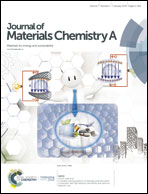Conjugated materials containing dithieno[3,2-b:2′,3′-d]pyrrole and its derivatives for organic and hybrid solar cell applications
Abstract
The growing number of new π-conjugated polymers and small-molecules has promoted the rapid development of organic solar cells (OSCs) over the past two decades. Among the most widely used building blocks, dithieno[3,2-b:2′,3′-d]pyrrole (DTP) and its derivatives have occupied an important position in both electron-rich and electron-deficient semiconductors since their first introduction into photovoltaic materials in 2007. The incorporation of basic DTP units such as N-alkyl DTP, N-acyl DTP and pyrrolo[3,2-d:4,5-d′]bisthiazole (PBTz), and their derivatives including fused DTP, and the lactam and imide conjugated heterocycles into photovoltaic polymers and small-molecules largely enhanced the open circuit voltage (VOC), short-circuit current (JSC), fill factor (FF) and finally power conversion efficiency (PCE) of OSCs. In this review, we provide a comprehensive overview of the progress in DTP-based materials, summarize the current state of DTP research and describe the relationship between the molecular structure and device performance, which could pave a way for the further rational design of novel DTP-derived building blocks and the corresponding photovoltaic materials.
![Graphical abstract: Conjugated materials containing dithieno[3,2-b:2′,3′-d]pyrrole and its derivatives for organic and hybrid solar cell applications](/en/Image/Get?imageInfo.ImageType=GA&imageInfo.ImageIdentifier.ManuscriptID=C8TA09383K&imageInfo.ImageIdentifier.Year=2019)
- This article is part of the themed collection: Recent Review Articles


 Please wait while we load your content...
Please wait while we load your content...